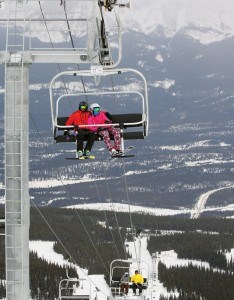
Parks Canada is defending itself after a news report surfaced last week that accused the agency of ignoring a scientific report critical of future development plans at Marmot Basin.
The 153-page report commissioned by the agency found that any new development at the ski area would threaten the Tonquin caribou herd, which is listed as threatened by the federal government.
Published in March 2014, the report was only recently made public by Dr. Fiona Schmiegelow, the report’s lead author, after she felt compelled to release it in response to Parks’ abrupt firing of Dr. John Wilmshurst, Jasper’s resource conservation manager.
The timing of the report’s release came more than a month after the federal government approved Marmot Basin’s first long range plan, which includes a new reservoir for snowmaking operations, expansion of its parking lots, upgrades to the Caribou Chalet and tree thinning on three ski runs.
The report is concerned about future development plans outlined in Marmot Basin’s site guidelines, which were published by Parks in 2008. The guidelines outline the projects Marmot would like to undertake in the coming years. In order for those projects to come to fruition, they have to first be included in a long range plan and then be approved by Parks.
According to Shawn Cardiff, Parks’ acting conservation manager, it’s too early to speculate what proposals will come forward in Marmot’s next long range plan or what projects Parks might consider.
In the guidelines, the ski area included a number of new projects, including the construction of new lifts both inside and outside its current boundaries.
According to the site guidelines, Marmot could propose to build new ski lifts in the Tres Hombres and Outer Limit areas and extend the Knob Chair outside of the ski area’s current boundaries.
The guidelines also state that because little is known about the impact these new ski lifts could have on the area, any decision would only be made after a caribou risk assessment and mountain goat study are completed.
“We’re following the process that we set out in the 2008 site guidelines and the report will be used for it’s intended purpose,” said Cardiff.
He said Parks intends to assess the report’s findings and use it when it begins to consider the ski area’s second long range plan this fall.
“Not only would the caribou risk assessment help us assess proposals it also helps us decide right at the outset about what we might consider and what we might not consider in the future long range plan,” said Cardiff.
Brian Rode,
vice president of marketing and sales for Marmot, declined to comment and in an email said Parks is handling all media requests.
According to Schmiegelow’s report, the Tonquin caribou population has dropped from 111 animals in 2006 to 54 caribou in 2011.
“New developments within the Tonquin range could exacerbate current conditions, and therefore would not be consistent with the need for active recovery efforts to address threats to the rapidly declining Tonquin caribou population,” stated the report.
Schmiegelow was unavailable for comment because she is working in the field.
Jill Seaton, chair of the Jasper Environmental Association, said she is concerned that Schmiegelow’s 2014 report is just being made public now.
The JEA has tried to get its hands on the report for months and even filed petitions with the Auditor General of Canada in 2008, raising its concerns about Marmot Basin’s site guidelines.
As part of Marmot’s approved long range plan, the ski area returned 118 hectares of land back to Parks.
Seaton criticized the leasehold reduction, saying it’s not an environmental gain for the park, as it’s been touted since the plan was approved.
The land is along Marmot’s northern boundary and includes a mineral lick and part of Whistlers Creek, which is considered valuable caribou habitat.
“It’s absolutely no substantial environmental gain at all,” said Seaton, “because what they want to do is put two ski lifts down next to it, so it’s going to disturb the caribou right there.”
Cardiff said the site guidelines are extremely prescriptive about what “exceptions” Marmot might get in return for the land transfer.
“In the future as part of that land exchange they have access to a license of occupation that they could develop for beginner skiing or cross country skiing and that’s a bit of land attached to the south end of their leasehold,” said Cardiff.
“But that’s subject to it being presented in a long range plan with public consultations.”
Marmot plans to submit a second long range plan in 2015 or 2016 after two wildlife assessments are completed, including a mountain goat study being conducted by researchers from the University of Laval.
Paul Clarke
[email protected]
